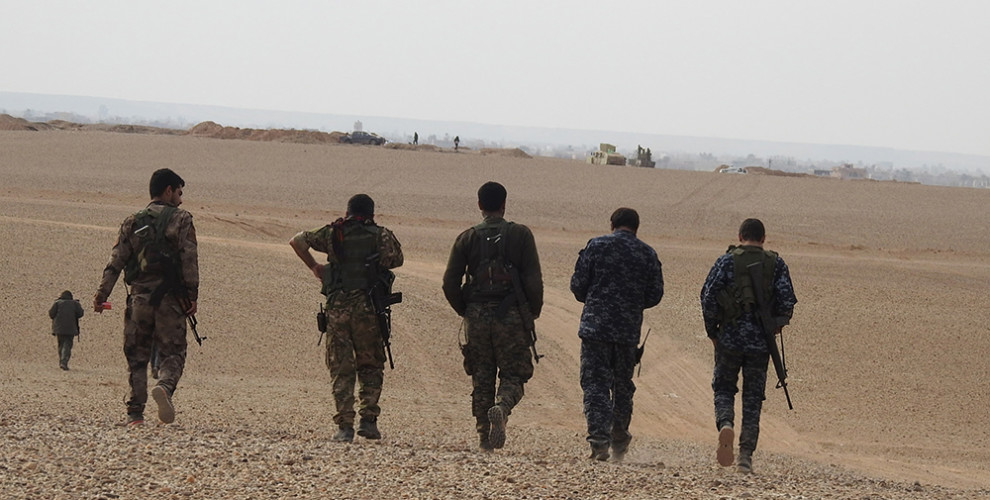War for will and labor in the deserts of Deir ez-Zor
The Operation Cizire Storm continues with great will and labor. It’s not just ISIS gangs being fought in Deir ez-Zor. The resistance is also against the incredibly harsh conditions of the desert.
The Operation Cizire Storm continues with great will and labor. It’s not just ISIS gangs being fought in Deir ez-Zor. The resistance is also against the incredibly harsh conditions of the desert.

The Operation Cizire Storm launched by YPG, YPJ and the Deir ez-Zor Military Council on September 9 continues on day 113. SDF forces advanced along the Euphrates River and have liberated many villages, hamlets and towns from ISIS gangs. But the shores of the Euphrates shouldn’t be understood as just villages, hamlets and towns. SDF fighters have to take miles of desert to liberate the residential areas along the river. For days, weeks and sometimes even months, the fighters advance in these deserts. But advancing in the deserts is nothing like advancing in villages or cities. The desert is too hot in the summer, and extremely cold in the winter. And of course there are the never-ending desert storms. Oftentimes visibility is down to less than a meter, which impedes fighters’ advance and gives the gangs opportunities to attack. So the fighters who advance in the desert wage a great war of labor, sacrifice and will.
GREAT PREPARATIONS TO STRIKE THE HEART OF ISIS
For a while we have witnessed the advance of fighters in the deserts of Deir ez-Zor. Every moment we witness is fighters resisting conditions well beyond the human will, often unbearable for the human physiology, which is awe inspiring.
SDF fighters have been advancing for weeks in the deserts, and are making the final preparations to advance into the Hajin town. To advance into Hajin, they need to cross 30 kilometers of desert and they need to take control of 4 villages around Hajin. Hajin has a dense population, it is called a village by locals but in reality it is a subdistrict. This subdistrict is fairly large and has a strategic position for ISIS gangs. Gangs fortify their lines of defense in this residential area mostly. Hajin is where the gangs do most of their war coordination as well. That is why the fighters are much more cautious about this town, and are very well prepared. And, taking control of Hajin will signify the start of a new phase in the Operation Cizire Storm, because taking this subdistrict with strategic significance to the gangs will mean a total fracturing of the gangs in this area. It will become nearly impossible for the gangs to hold on and defend themselves in the remaining villages. In short, Hakin is the heart of ISIS in this area along the Euphrates River.
THE ADVANCE BEGINS
By three in the afternoon, fighters have completed all preparations, and they take to the road with armored vehicles in the lead and vehicles that carry the fighters following them. As the convoy continues, fighters chanting slogans in the open backed cars can be heard. Occasionally a fighter starts to sing in Arabic, and his friends accompany him. It is very cold outside, and the cold desert air gets more intense as darkness falls. When we put our camera outside to record the advance of the vehicles, the cold is so intense that I have to put my hand back inside the car before one minute is up. But fighters keep singing, chanting and laughing like it’s nothing. Their morale and enthusiasm motivates us too.
When we arrive in the final stop, it is fully dark. Bulldozers immediately start building positions. The fighters make earthen positions they call “satir” to be able to survive the desert. These earthen positions are used both as fighting positions and shelter. Fighters start immediately to carry the tents and other equipment to be set up inside the positions. Armored vehicles and DShK-laden vehicles take position in case of an attack. As they continue to prepare in the pitch black desert, we return to the press point to return the next day.
CLASHES AND VICTORY IN THE FIRST VILLAGE THEY ENTER
When we arrive the next day, the positions have long been completed and tents have been set up inside. It’s like they didn’t just arrive one night ago, but they had been there for months. The logistics vehicles bring food to the positions, which is distributed to all. After the meal and the final preparations for the armored vehicles, a message comes through the radio stating that clashes have broken out between groups of fighters who arrived in the village and the gangs, and asks for backup. Attack groups have taken action at night and fighters have already entered the first villages. Armored vehicles and fighters immediately leave for the clash zone. A group of fighters enter the village as support troops, while armored vehicles shoot at ISIS positions from a distance to cover the fighters on their way to the clash zone. Clashes between the fighters and the gangs continue for hours. Everybody is waiting, holding their breath. The village is far from us, the battle coordination didn’t allow us in too close. But we can see the smoke rising from the village. The constant sound of bullets show that the clashes are intense. After over 3 hours of intense clashes, a fighter shouts over the radio: “Bijî berxwedana YPG’ê!” The gangs have been broken, many gang members have been killed. Fighters are chanting for victory again. As we head out to return to our position, commanders congratulate their fighters over the radio.
Two days after the clashes, fighters liberate al-Qehawi, Eal-Jabal, al-Kishkiya and Jab al-Behra villages.